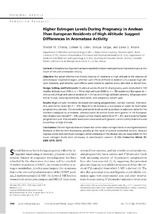Higher estrogen levels during pregnancy in Andean than European residents of high altitude suggest differences in aromatase activity

View/
Date
2014-08Author
Charles, Shelton M
Julian, Colleen Glyde
Vargas, Enrique
Moore, Lorna G
Metadata
Show full item recordAbstract
Context: Uteroplacental hypoxia has been reported to lower estrogen levels in preeclampsia as the
result of reduced aromatase activity.
Objective: We asked whether the chronic hypoxia of residence at high altitude in the absence of
preeclampsia lowered estrogen, whether such effects differed in Andean vs European high-altitude residents, and whether such effects were related to uterine artery diameter or blood flow.
Design, Setting, and Participants: Studies at weeks 20 and 36 of pregnancy were conducted in 108
healthy Bolivian low- (400 m, n 53) or high-altitude (3600 m, n 55) residents of European (n
28 low and 26 high altitude) or Andean (n 25 low and 29 high altitude) ancestry. All groups were
similar in age, nonpregnant body mass index, and pregnancy weight gain.
Results: High-altitude residence increased circulating progesterone, cortisol, estrone, 17 -estradiol, and estriol levels (all P .01). High-altitude Andeans vs Europeans at week 36 had higher
progesterone, estrone, 17 -estradiol, and estriol levels as well as product to substrate ratios for the
reactions catalyzed by aromatase, whereas week 36 cortisol levels were greater in the European
than Andean women (all P .05). Lower cortisol, higher estriol (both P .01), and trends for higher
progesterone and 17 -estradiol levels were associated with greater uterine artery diameters and
blood flow at high altitude.
Conclusions: Chronic hypoxia does not lower but rather raises estrogen levels in multigenerational
Andeans vs shorter-term Europeans, possibly as the result of greater aromatase activity. Because
hypoxia alone does not lower estrogen, other attributes of the disease may be responsible for the
lower estrogen levels seen previously in preeclamptic women. (J Clin Endocrinol Metab 99:
2908–2916, 2014).
